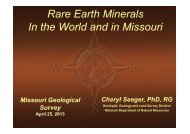Create successful ePaper yourself
Turn your PDF publications into a flip-book with our unique Google optimized e-Paper software.
diorites, and their associated pegmatites. The<br />
m<strong>in</strong>eral usually occurs as black to dark brown and<br />
brownish-violet tabular gra<strong>in</strong>s. It has a conchoidal<br />
fracture and is often metamict (i.e., its crystal lattice<br />
is disrupted while the m<strong>in</strong>eral gra<strong>in</strong> reta<strong>in</strong>s its<br />
orig<strong>in</strong>al morphology) due to radioactive decay of<br />
thorium, which can weaken the crystal structure. A<br />
microscopic dark halo or r<strong>in</strong>g seen <strong>in</strong>side of allanite<br />
m<strong>in</strong>eral gra<strong>in</strong>s is also an effect caused by radioactivity<br />
(Long, Van Gosen, Foley, and Cordier, 2010).<br />
The specific gravity of allanite is 3.4 to 4.2 and its<br />
hardness is between 5 to 6.5 Moh’s scale (Deer and<br />
others, 1967); these characteristics suggest a possibility<br />
for placer concentrations. However, metamict<br />
varieties may weather rapidly. Weather<strong>in</strong>g of<br />
allanite produces a reddish-brown, iron-rich, <strong>earth</strong>y<br />
crust deficient <strong>in</strong> REE compared to unweathered<br />
allanite (Deer and others, 1967).<br />
Bastnasite (Ce,La,Y)CO 3 F<br />
Bastnasite, also spelled bastnaesite or bastnäsite, is<br />
an uncommon REE-bear<strong>in</strong>g carbonate m<strong>in</strong>eral (cerium-lanthanum-yttrium<br />
carbonate fluoride) that<br />
occurs <strong>in</strong> a m<strong>in</strong>eral series with hydroxyl-bastnasite<br />
[(Ce,La)CO 3 (OH,F)]. It is also closely related to<br />
parisite [Ca(Ce,La) 2 (CO 3 ) 3 F 2 ], and may form replacement<br />
crystals after allanite (Long, Van Gosen,<br />
Foley, and Cordier, 2010). Although bastnasite is<br />
not common, it is the most abundant REE-bear<strong>in</strong>g<br />
m<strong>in</strong>eral (M<strong>in</strong>Dat.org, 2011).<br />
Bastnasite is primarily m<strong>in</strong>ed from <strong>rare</strong>, carbonaterich<br />
igneous rocks called carbonatites. Carbonatites<br />
conta<strong>in</strong> greater than 50 percent carbonate m<strong>in</strong>erals<br />
and are usually associated with alkal<strong>in</strong>e igneous<br />
complexes. Bastnasite is one of the world’s primary<br />
sources for REE, and is dom<strong>in</strong>ated by LREE (Hedrick,<br />
2004). Bastnasite theoretically can conta<strong>in</strong><br />
about 75 percent REO, but averages about 60<br />
percent. Its yttrium content is generally very low at<br />
about 0.05 percent (Hedrick, 1985). In addition<br />
to be<strong>in</strong>g found <strong>in</strong> carbonatites, bastnasite is known<br />
as an accessory m<strong>in</strong>eral <strong>in</strong> some alkal<strong>in</strong>e igneous<br />
rocks and <strong>in</strong> some hydrothermal deposits (Hedrick,<br />
2004).<br />
Bastnasite may be massive or granular and typically<br />
forms small, rounded hexagonal or short prismatic<br />
crystals; it may also occur as spheres or rosettes<br />
13<br />
(Long, Van Gosen, Foley, and Cordier, 2010). It is<br />
transparent to translucent, with a vitreous to greasy<br />
or pearly luster. Its color varies from colorless to<br />
shades of yellow, reddish-brown, and p<strong>in</strong>k. Bastnasite<br />
is relatively heavy with a specific gravity of 4.7<br />
to 5.0. However, its low Moh’s hardness of 4.0 to<br />
4.5 (M<strong>in</strong>Dat.org, 2011), comb<strong>in</strong>ed with its brittleness<br />
and a prom<strong>in</strong>ent basal cleavage, suggest little<br />
possibility for placer concentrations.<br />
Euxenite (Y,Er,Ce,U,Pb,Ca)<br />
(Nb,Ta,Ti) 2 (O,OH) 6<br />
Euxenite is a slightly radioactive oxide m<strong>in</strong>eral<br />
<strong>in</strong> a series with polycrase [(Y,Ca,Ce,U,Th)<br />
(Ti,Nb,Ta) 2 O 6 ]. Euxenite has similar properties to<br />
other REE-bear<strong>in</strong>g oxide m<strong>in</strong>erals such as fergusonite<br />
and samarskite, both uranium m<strong>in</strong>erals,<br />
and to aeschynite, a m<strong>in</strong>or REE-bear<strong>in</strong>g m<strong>in</strong>eral.<br />
Euxenite is typically found <strong>in</strong> granite pegmatites <strong>in</strong><br />
association with quartz, feldspars, columbite (ferrocolumbite),<br />
tantalite (ferrotantalite or manganocolumbite),<br />
and monazite (Long, Van Gosen, Foley,<br />
and Cordier, 2010; M<strong>in</strong>Dat.org, 2011).<br />
Euxenite generally forms black to yellow- or greent<strong>in</strong>ged,<br />
greasy to submetallic, tabular to prismatic<br />
crystals. Metamict crystals are often partially<br />
amorphous. The m<strong>in</strong>eral may also be granular to<br />
massive, or may form radial aggregates. It is brittle,<br />
exhibits a conchoidal fracture, and has no cleavage.<br />
Its Moh’s hardness of 5.5 to 6.5 and specific gravity<br />
of 5.3 to 5.9 facilitate its concentration <strong>in</strong> placer<br />
deposits such as <strong>in</strong> detrital black sands (Long, Van<br />
Gosen, Foley, and Cordier, 2010; M<strong>in</strong>Dat.org,<br />
2011).<br />
Monazite (Ce,La,Y,Th)PO 4<br />
Monazite is a REE-thorium phosphate m<strong>in</strong>eral that<br />
is similar to bastnasite as a LREE ore. However, it<br />
hosts slightly more of the HREE, especially yttrium,<br />
dysprosium, and gadol<strong>in</strong>ium (Hedrick, 2004).<br />
Monazite can theoretically conta<strong>in</strong> 70 percent<br />
REO, <strong>in</strong>clud<strong>in</strong>g about 2 percent yttrium oxide. In<br />
reality, most concentrates conta<strong>in</strong> about 55 to 65<br />
percent REO (Hedrick, 1985), with typical values<br />
<strong>in</strong> the 60 to 62 percent range (Long, Van Gosen,<br />
Foley, and Cordier, 2010). Monazite’s high thorium<br />
content (4.5 to10 percent ThO 2 equivalent)<br />
and thorium’s naturally occurr<strong>in</strong>g radioactivity is



